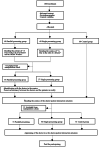We are all ordinary: the shared visual narratives of daily life promote the patients' positive attitudes toward doctors
- PMID: 38812042
- PMCID: PMC11137884
- DOI: 10.1186/s40359-024-01820-8
We are all ordinary: the shared visual narratives of daily life promote the patients' positive attitudes toward doctors
Abstract
Background: Current research on the doctor-patient relationship primarily focuses on the responsibilities of doctors, with relatively less emphasis on examining the contributions patients can make. As a result, there is an urgent demand for exploring innovative approaches that highlight the active role patients play in cultivating a robust doctor-patient relationship. The purpose of this study was to devise an intervention strategy centered around patients to enhance the doctor-patient relationship. Comics were developed to depict shared narratives encompassing challenging daily life experiences between doctors and ordinary individuals. The study aimed to assess the efficacy of this approach in cultivating positive attitudes toward doctors.
Method: A 3-group design trial was conducted in Shanghai, China. A total of 152 participants were randomly assigned to one of three conditions: the parallel presenting group (n = 51), where narratives about a doctor and an ordinary employee were presented side by side in comics; the single presenting group (n = 50), where only narratives about a doctor were presented; and the control group (n = 51). The outcomes assessed in this study encompassed changes in identification with the doctor portrayed in the comics, perceived intimacy between doctors and patients in reality, and appraisal of the doctor in a prepared doctor-patient interaction situation.
Results: The parallel presenting group exhibited significantly larger increases in identification with the doctor portrayed in the comics, perceived intimacy between doctors and patients in reality, and appraisal of the doctor in a prepared doctor-patient interaction scenario compared to the single presenting group. The observed enhancements in the appraisal of the doctor in a prepared doctor-patient interaction scenario can be attributed to the changes in identification with the doctor portrayed in the comics experienced by the participants.
Conclusion: Our study responds to the doctor-centric focus in existing research by exploring patients' contributions to the doctor-patient relationship. Using comics to depict shared narratives, the parallel presenting group demonstrated significantly increased identification with the depicted doctor, perceived intimacy, and positive appraisal in prepared scenarios compared to the single presenting group. This underscores the effectiveness of patient-centered interventions in shaping positive attitudes toward doctors, highlighting the pivotal role patients play in fostering a resilient doctor-patient relationship.
Trial registration: Chinese Clinical Trail Registry: ChiCTR2400080999 (registered 20 February 2024; retrospectively registered).
Keywords: Common ingroup identity model; Doctor-patient relationship; Identification; Visual narratives.
© 2024. The Author(s).
Conflict of interest statement
The authors declare no competing interests.
Figures






Similar articles
-
The Effect of Screen-to-Screen Versus Face-to-Face Consultation on Doctor-Patient Communication: An Experimental Study with Simulated Patients.J Med Internet Res. 2017 Dec 20;19(12):e421. doi: 10.2196/jmir.8033. J Med Internet Res. 2017. PMID: 29263017 Free PMC article.
-
Delivery of patient-centered care in complementary medicine: Insights and evidence from the Chinese medical practitioners and patients in primary care consultations in Hong Kong.Complement Ther Med. 2019 Aug;45:198-204. doi: 10.1016/j.ctim.2019.06.013. Epub 2019 Jun 20. Complement Ther Med. 2019. PMID: 31331561
-
Comics and medicine: peering into the process of professional identity formation.Acad Med. 2015 Jun;90(6):774-9. doi: 10.1097/ACM.0000000000000703. Acad Med. 2015. PMID: 25853686
-
Doctor-patient communication and satisfaction with care in oncology.Curr Opin Oncol. 2005 Jul;17(4):351-4. doi: 10.1097/01.cco.0000167734.26454.30. Curr Opin Oncol. 2005. PMID: 15933466 Review.
-
[Illness narratives and narrative medicine].Rehabilitation (Stuttg). 2008 Apr;47(2):90-7. doi: 10.1055/s-2008-1042447. Rehabilitation (Stuttg). 2008. PMID: 18370360 Review. German.
References
Publication types
MeSH terms
Grants and funding
LinkOut - more resources
Full Text Sources
Medical
Research Materials

